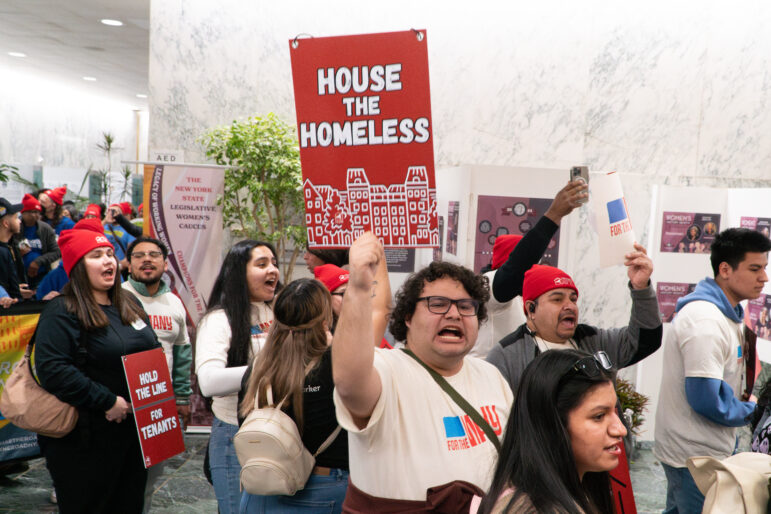
Photo by: Adi Talwar
Stacy Seecharan started B & S Iron Works in the Bronx in 2003 and she said about 80 percent of her more than $1 million annual revenue comes from government contracts. She also said the programs the city runs to help certified business owners have helped her tremendously.
The story of Mayor Bloomberg’s legacy will be framed by his goal to run a city government like the corporation that made him a billionaire.
But the story of the city’s minority- and women-owned business enterprises program—which aimed to substantially increase the share of city contracts going to those firms—is a story that does not mesh with the usual tale told about Bloomberg’s New York, of a city run efficiently, like a profitable business, using the latest technology and operated by a leader who sets goals and achieves them. New York City’s M/WBE program displays little accountability, incomplete or misleading data and continued failure to meet its goals.
A review of contract data, city documents and transcripts, as well as dozens of interviews with interested parties, suggests the program—admittedly a tiny piece of the city that Bloomberg will hand over to a new administration in January—was never a priority for the administration. Minority- and woman-led firms faced obstacles in qualifying for the work. And the law that created the program in 2005, as well as an amended version passed early this year, are full of contradictions and questionable numbers.
An initiative resurrected
In 1992, Mayor Dinkins created New York City’s first program to increase the amount of business the city gave to companies owned by minorities and women. “I hope the day comes soon when we are treated fairly and equally for our good work, not denigrated because of our gender or whence our ancestors came,” Dinkins said at the time, according to The New York Times.
Dinkins recognized that the city had become a passive participant in a system of discrimination, so, by executive order, he set a goal of awarding 20 percent of city contracts to businesses owned by minorities or women.
The program did not last long.
After Rudolph Giuliani defeated Dinkins in 1993, he dissolved the program immediately after taking office, calling it “reverse discrimination” against white men. No program existed for a decade.
Then in 2003, in his second year in office, Bloomberg issued an executive order to restart the M/WBE program. That same year, the City Council contracted Mason Tillman Associates, Ltd. to conduct a disparity study to determine whether the city’s contracting process was fair.
Completed in 2005, the 294-page study determined there was a significant disparity in the number of able minority- and women- owned companies getting city contracts in a number of industries. The Council held hearings and eventually passed Local Law 129 in late 2005. The law, which the mayor signed, set citywide goals for prime contracts — contracts awarded directly to a company from a government — under $1 million in certain industries and for certain minority groups.
The disparity study and new law came under immediate criticism from groups of minority- and women-owned businesses, including the Coalition of Hispanic Chambers of Commerce, Queens Hispanic Chamber of Commerce, New York Statewide Coalition of Hispanic Chambers, Regional Alliance for Small Contractors and Asian Women in Business. The groups argued against the $1 million cap and believed that the percentage goals were not high enough.
Still, the law was not challenged in court and, for the most part, its passage was heralded as a major breakthrough for fairness in the way the city spends its money.
The mayor cheers results
In the years following, depending on one’s viewpoint, the program has either been a great success or an immense failure.
As of early October, 3,796 minority- and women-owned businesses are certified with the city, up from about 700 in 2006.
To qualify for certification in New York City’s Minority- and Women-Owned Business Enterprise Program, a company must be at least 51 percent owned by a U.S. citizen who is either a member of a minority group or a woman. The ownership interest has to be “real, substantial and continuing,” and the owner must “exercise the authority to control independently the day-to-day business decisions of the enterprise.”
The Color of Contracts: New York’s MWBE Program
Read the entire series here.
According to the Bloomberg administration, since the law went into effect in 2006, certified companies have won more than $3 billion in contracts from the city; 877 of those certified M/WBE companies won jobs in fiscal year 2013.
“This is real progress that benefits our entire city because as more business are able to open operate and expand, the stronger New York City’s economy becomes and the better prices taxpayers get for public works and services. And that’s why we are so determined to continue to support our city’s M/WBE firms,” said Bloomberg at a forum in 2012.
Critics differ
But while Bloomberg’s press releases and speeches report the total dollars contracted and total number of certified firms involved, they steer clear of discussing the percentage of city dollars going to M/WBE firms. In the last five fiscal years, the agencies under control of the mayor have fallen short of every goal established by the law for prime contracts.
(See full statistics on the city’s MWBE performance here.)
Where the city is doing the worst is in construction contracts for black business owners, who in 2013 were awarded 2.36 percent of prime contracts under $1 million when the goal is 12.63 percent. That gap between goal and performance was actually an improvement for black construction firms, who were awarded 0.21 percent of jobs the previous fiscal year.
Though M/WBEs represent about 7 percent of all the vendors doing business with the city, the number of contracts won by MWBEs in fiscal year 2013 was an impressive 23 percent of all subcontracts and prime contracts covered by the program, according to the Department of Small Business Services (SBS). But since so many of those contracts are small, their share of total contract dollars—the measure that matters in the law—is puny.
According to the city comptroller, so far in 2013, 4.3 percent of the city’s $57.3 billion in prime contracts went to M/WBEs, compared to 3.4 percent in 2012 and 3.1 percent in 2011, according to the report card. Those percentages include prime contract payments from 72 agencies.
The Small Business Services disputes those comptroller numbers because subcontracts are not included and SBS only has jurisdiction over 34 mayoral agencies. Indeed, the city seems to be doing much better in subcontracting: Through fiscal year 2013, M/WBE subcontractors have been awarded $1.17 billion and won a high percentage of subcontracts under $1 million in recent years—38 percent in fiscal year 2013 and 42 percent the year before.
But the available data is not broken down so it can be compared to goals established for subcontracts in the law. What’s more, the totals going to M/WBEs for each year—$109 million in fiscal year 2013 and $129 million the year before—represent a small slice of the city’s annual spending.
For the most part, organizations created to advocate for minority and women in different industries have been very critical of the city’s performance, as have a number of elected officials, especially Councilwoman Letitia James (the Public Advocate-elect), Comptroller John Liu and Councilman Charles Barron.
“[T]he lack of minority participation in city contracts is a plague,” said Liu in an interview with Black Enterprise in 2013.
“[I]n 2005, 16 percent of the companies that were able to receive—available to receive—construction contracts, 16 percent were black.” Barron said, according to a City Council transcript, in 2012. “We only got 1 percent of those contracts. It did not get a whole lot better. We got 1 percent, 3 percent, 4 percent in all of the four categories of goods, professional services, and construction contracts.”
The SBS defends its performance, arguing that it must adhere to contracting laws that limits its flexibility to push the M/WBE goals.
“State law requires that a majority of contracts be awarded to responsible vendors that submit the lowest responsive bids or the best proposal. Despite these limitations, the city continues to make great strides in contracting areas where agencies have most discretion and flexibility,” reads the Small Business Services annual report for fiscal year 2013.
This series was made possible by Long Island University’s George Polk Investigative Reporting Grant. To read part 2, go here.








